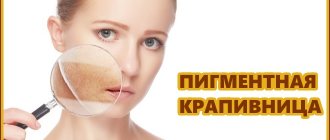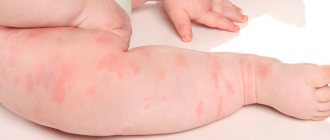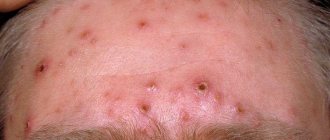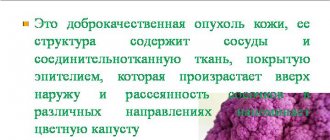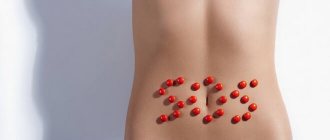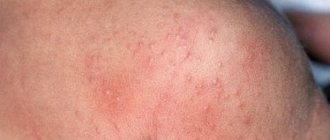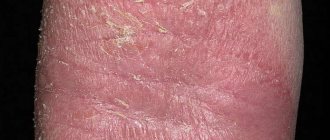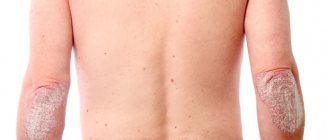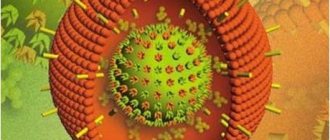What to do first
The first thing you need to do is go to see a doctor at the first rash on your skin. Which doctor should I go to? To begin with, it is worth visiting an allergist or dermatologist, and later also a gastroenterologist, because rashes are closely related to the functioning of the gastrointestinal tract. The doctor carries out diagnostic measures and finds out the provoking factors. These factors are the determining element of correct treatment, which is selected individually. It is important to always remember that eliminating its causes will help get rid of hives. Based on the fact that the disease is not at all uncommon, some basics of treatment will come in handy. How to diagnose the cause? To find out the reason, you need to undergo some tests.
- Detailed blood and urine tests. This is necessary in order to find out whether all organs are functioning normally and to look at the level of eosinophils in the blood.
- Test for HIV, hepatitis B and C, syphilis.
- If any abnormalities are found, additional tests are prescribed to find out how the thyroid gland is working or an ultrasound of the organs.
- Immunoglobulin testing.
And this is not the entire list of studies. If there are any deviations from the norm, an additional examination is prescribed.
To determine the cause of the disease, you will have to donate blood for analysis.
Standard therapeutic line
Initially, antihistamines are prescribed for urticaria. If you have urticaria, the following medications may be prescribed: suprastin, tavegil, citrine, alerzin, edem, loratadine. Previously, antihistamines were released that caused addiction, and each time the dosage had to be constantly increased. Currently, new drugs of the third and fourth generation have been released, which can be taken every time at the first manifestation of an allergy. And they are not addictive. Treatment of acute urticaria often involves taking mild sedatives. Can be used:
- valerian;
- motherwort;
- echinacea;
- person;
- novopassitis;
- phytosed
When there are no visible results after starting therapy, it is necessary to use drugs based on hydrocorticosteroids. This therapy is effective. Its essence is that it temporarily blocks the functioning of the immune system. Signs of an allergic reaction are removed. But, there are a number of side effects. The most basic thing that blocking the immune system can lead to is frequent colds. Basically these are ointments based on these hormones. In the form of an ointment, the risk of side effects is much lower. Here's a small list:
- hydrocortisone;
- prednisolone;
- dexamethasone.
The safest method, comparatively, is plasmapheresis. Least side effects. This is a blood transfusion. Using a special apparatus, the blood is distilled and purified from immunoglobulins. During such treatment, it is important to provide the body with a gentle regime.
Prednisolone - hormonal ointment
Glucocorticosteroids
To treat acute urticaria in adults, medications from the group of systemic glucocorticosteroids are used. Patients are given intravenous Prednisolone, Diprospan or Dexamethasone. The drugs suppress the activity of enzymes that cause inflammation of the skin and mucous membranes. However, the steroid drug simultaneously enters healthy tissues, and therefore has a number of side effects - increased blood pressure, arrhythmia, increased excitability, muscle weakness, ulcerative bleeding.
Important! Glucocorticosteroids are prescribed only for generalized urticaria and anaphylactic shock.
Causes of drug-induced urticaria
There is a diagnosis such as drug urticaria. This rash appears after taking certain medications. This reaction of the body is very dangerous. Hives are the most common side effect after taking medications. Why does the reaction occur:
- may provoke individual intolerance to one of the components of the drug;
- tendency to allergies;
- metabolic disorders;
- dosage is not appropriate;
- taking incompatible medications;
- unnecessary intake of vitamins;
- combination with alcohol;
- pathologies of the liver and kidneys.
Any medication can cause a reaction. If many years ago there were manifestations upon contact with any drug, it may appear again upon contact with any component of this medicine.
Here are some drugs that cause urticaria: sulfonamide, tetracycline, penicillin, aminoglycoside, quinolone, chloramphenicol, antirheumatic drugs, barbiturates, icecaine, B vitamins, local anesthetics, etc.
Alcohol combined with medications can cause hives
How does urticaria manifest?
Most often, it is characterized by the manifestation of an acute form. In most cases it manifests itself sharply. This is itching, redness. The blistering rash can be located all over the body or in isolated areas. Additionally, the following symptoms may be present:
- headache;
- dizziness;
- joint pain;
- inflammation and itching of the eyes, mucous membranes;
- dyspnea;
- bronchospasm;
- damage to the kidneys and heart.
And here a natural question arises: how to treat medicinal urticaria? First you need to clearly know which medicine caused the reaction. You should stop taking this drug immediately. If the treatment consisted of a complex of drugs, sometimes you have to cancel everything. Acute urticaria, which is accompanied by severe itching and a large rash of skin, can be treated with antihistamines.
If the symptoms are relieved very poorly, then corticosteroids are added in the form of an ointment or systemically. Plus, you definitely need to remove toxins from the body; enterosorbents and drinking plenty of fluids will help.
What is urticaria? Types of urticaria
Urticaria is a common skin disease that most often has an allergic origin. It is characterized by the appearance of a specific rash in the form of itchy flat blisters. The blisters are similar to sting marks from nettles, which is how the disease got its name.
What is emotional burnout:
This is a fairly common allergic reaction. According to statistics, every third inhabitant of our planet has encountered unpleasant manifestations of urticaria at least once in their life.
There are acute and chronic forms of urticaria. In the acute form of urticaria, the rashes appear suddenly, last from one to two weeks (they can change their localization within the surface of the human body, as well as the mucous membrane), then gradually disappear. In the chronic form, foci of urticaria appear and disappear, and relapses can continue for a year or more.
Blisters that appear with urticaria disappear almost without a trace, leaving no traces on the skin.
The most dangerous form of acute urticaria is Quincke's edema . It manifests itself in the fact that the skin in a certain area of the body swells and becomes pale. Swelling can last from two to three hours to several days. If the swelling spreads to the area of the larynx and face, it can cause suffocation, so at the first sign of such an allergic reaction, you should immediately consult a doctor or call an ambulance.
Forms of urticaria also differ according to the allergens that caused it. They can be of any origin, for example, medicinal, food, household, and so on. The most common allergic reaction to drugs, especially antibiotics. There is also contact urticaria, caused by contact of the skin and an allergen (most often household chemicals, low-quality clothing, and so on).
There are also types of physical urticaria such as cold, heat, solar, vibration.
First aid for acute manifestations of urticaria
Anaphylactic shock and Quincke's edema are terrible manifestations of urticaria that require immediate surgical intervention. There is a sharp deterioration in breathing due to swelling of the larynx, a decrease in blood pressure, and fainting is also possible. What to do? The first thing to do is call an ambulance. It is necessary to lay the person in a horizontal position, because due to pulmonary edema his breathing is difficult. The patient's legs should be elevated to at least slightly stabilize the pressure. Injection of adrenaline or dexamethasone. Typically, people who experience such attacks know the characteristics of their body, and the patient may have a syringe with medicine with him. The injection is given intramuscularly. Injections for urticaria are an immediate remedy.
- Adrenalin. The number one drug helps well with anaphylactic shock or any other severe allergy attack. 1 ml of 0.5% solution is administered intramuscularly. If there is no effect, you can repeat it after ten minutes. This is a vasoconstrictor drug that has a restorative effect on the heart muscle.
- Prednisolone. Dosage 90-120 ml. For acute reactions, it is necessary to administer every four hours. A steroid-based drug that has anti-allergic and anti-shock effects.
- Diphenhydramine in a dosage of 2 ml of 1% solution, administered every four to six hours. Antihistamine.
An injection of adrenaline will help with anaphylactic shock
General algorithm for the treatment of urticaria
Hives itself is one of the symptoms of more serious diseases, so treatment should include a set of certain actions. They should include measures aimed at generally strengthening the body’s resistance and reducing the manifestation of symptoms:
- injections, tablets for urticaria;
- topical preparations: creams, ointments that relieve itching and swelling;
- diet;
- physiotherapy.
Antibiotics for urticaria - is it possible or not? For any manifestations of allergies, antibiotics are not recommended. Unless, perhaps, when an acute respiratory viral infection develops against the background of an allergy. This happens because the body is weakened and is very susceptible to attack by various microbes. In a state of exacerbation of allergies, a person can get sick when someone simply sneezes near him, the protective functions are so reduced.
Antibiotics are prescribed if there is an increase in body temperature due to the development of infection. But, they are prescribed with great caution.
Treatment with vitamins
Vitamins for urticaria can have a positive effect in eliminating the symptoms of urticaria naturally. B vitamins are a natural antihistamine. The remedy for hives is vitamins.
- Vitamin A. This drug is available in capsules. Helps reduce the appearance of rashes.
- Nicotinamide. This vitamin prevents histamine from being released, that is, it seems to block it. Mainly found in vitamin complexes.
- Vitamin C. Helps reduce capillary permeability.
- Magnesium. It is its deficiency that can cause a rash.
- At 12, one ampoule per day is prescribed intramuscularly. Reduces the manifestations of allergies.
Vitamins significantly ease the condition of urticaria
Toxin-removing drugs for urticaria
Urticaria causes a rash to appear on the skin. And this is a consequence of poor functioning of the pancreas or liver. Toxins accumulate in the body, and when their quantity is already very high, a reaction appears in the form of a rash on various parts of the body. Therefore, various sorbents are widely used in the treatment of urticaria in adults. Activated carbon, black or white, is the most common and cheapest drug that can remove toxins. There are also other drugs: polysorb - an analogue of coal, enterosgel, gastrosorb, carbactin, carbolene, filtrum, lingosorb, polyphepan. The chronic form of urticaria can greatly affect the patient's nervous state. Constant itching and the lack of aesthetics of this problem cause sleep disturbances and psychological complexes. Urticaria is often accompanied by symptoms such as:
- sleep disturbance;
- headache;
- irritability;
- emotional disorders.
Therefore, it is also common to treat urticaria in adults with antidepressants.
How to cure hives
It is difficult to predict where rashes may appear. “Favorite” places are on the face, neck, buttocks, and in general, manifestations occur in almost any area of the body. The reaction is caused by excess production of histamine, which regulates many physiological processes. Children, as a rule, suffer from acute urticaria. Symptoms of the disease appear unexpectedly and disappear just as quickly. Adults, often women, are more susceptible to chronic disease, which can manifest as recurrent or persistent disease.
The classification of allergic pathologies is closely related to the causes that cause it. So, urticaria can be:
- food;
- aerogenic – in the presence of plant pollen, microparticles of pet hair, etc. in the air;
- infectious;
- papular - from insect bites;
- thermal (cholinergic) – upon contact with a hot environment;
- cold – as a reaction to low temperature;
- aquagenic - upon contact with water;
- solar – as a result of exposure to ultraviolet radiation from the sun;
- medicinal;
- psychogenic – arising from nervous conditions;
- pseudo-allergic – provoked by hepatitis, worms;
- autoimmune;
- idiopathic – if the cause of the allergy is not clear.
How to treat hives? The most important condition is an integrated approach. It is rarely possible to recover completely and permanently from this disease. However, effective therapeutic methods help to significantly reduce the frequency of allergy exacerbations. The main and most difficult thing is to identify the true cause of the disease. Urticaria should be treated based on the “three therapeutic pillars”:
- medicines;
- hypoallergenic diet;
- physiotherapeutic procedures.
- How to distinguish edible mushrooms from inedible ones with photos and videos. Names and descriptions of edible and inedible mushrooms
- Hypertension - what is it?
- How to lose weight with flax seeds
How to treat urticaria in adults
In this category of patients, the disease proceeds mainly as a chronic pathology. Drug treatment of urticaria at home in adults includes the use of:
- antihistamines;
- desensitizing (reducing sensitivity to allergens) agents;
- hormonal drugs (for severe forms of urticaria);
- medications that normalize the functioning of the adrenal glands;
- multivitamins.
Treatment of urticaria in children
The very delicate skin of a small child becomes a quick victim of allergies. How to treat urticaria in children? The principles of therapy are the same as for adults. First of all, contact with the source of allergic reactions should be identified and eliminated. Antihistamines help suppress the inflammatory process. The condition of blood vessels is improved by calcium dosage forms.
You can treat itching by bathing your child in a bath with a decoction of string or nettle. Older children can lubricate the affected skin with Menovazine - a solution containing anesthesin, novocaine, menthol. If the disease is very severe, doctors prescribe hormonal ointments. To quickly eliminate swelling and free the body from toxins, diuretics and sorbents (Enterosgel, Polysorb, Smecta) are used.
Ointments for urticaria
The cure for urticaria, or rather, to reduce external manifestations, is mainly ointments. Their operating principle is approximately the same, but the composition is different. Depending on the composition there are:
- hormonal ointments;
- non-hormonal ointments and creams.
The second group has fewer side effects, and if the urticaria is not in an advanced form, then you can get by with these ointments, some of them are suitable even for children: zinc, skin-cap, fenistil, bepanten, la-cree, nezulin.
La-Cri can also be used by children
How do different forms of the disease manifest?
The disease comes in several forms, among which acute urticaria appears suddenly. In the acute form of the disease, the rash is present for a short time, about 1-2 days. The disease lasts for several days. The cause of its appearance is most often an allergy to certain foods or medications. It appears when using various medicinal serums, vaccines and blood transfusions.
The main symptoms include:
- the appearance of a rash and itching;
- blisters are round in shape, but in some cases irregular and slightly oblong;
- the rashes are slightly elevated above the epidermis and have a matte color in the middle, with a pink border around the edges;
- the rash may appear in separate areas and then merge into a single area;
- fever and chills;
- gastrointestinal disorders;
- malaise;
- the rash spreads over the torso, arms and buttocks;
- sometimes, rashes can be localized on the mucous membranes.
Acute urticaria also appears due to mechanical damage. The atypical form differs from the acute linear form of the rash; there is no itching.
Acute urticaria also includes Quincke's edema. The disease may also be called giant urticaria or angioedema. Symptoms of the disease include the appearance of swelling of the epidermis or mucous membranes.
The skin in such affected areas has a compacted structure and a white tint. In some cases, it may be pink. And there is also a feeling of burning and itching, but not always. Most often, swelling goes away within 1-2 days. If appropriate treatment is not carried out, a relapse is possible. Sometimes swelling can appear in combination with the usual form of the disease. Swelling is localized in the larynx, which can cause asphyxia. Under certain conditions, swelling may appear in the orbital area, which leads to deterioration of vision.
Chronic urticaria is a long-term process of sensitization that is caused by chronic inflammation. These include caries, tonsillitis and others. Problems with the gastrointestinal tract and liver may also be the cause. The disease has a paroxysmal process. Unlike the acute form, the rash is not significant. They can appear on different parts of the body. Present:
- general weakness;
- temperature;
- headache;
- painful sensations in the joints;
- if the gastrointestinal tract is affected, nausea and vomiting are possible;
- increased itching, which can cause neurotic disorders and sleep disturbances.
Treatment is selected individually, depending on the nature of the disease and its course. Before dealing with urticaria, it is necessary to conduct a thorough diagnosis.
Nausea and vomiting accompany chronic urticaria
Physiotherapy of urticaria in adults
This therapy can speed up the healing process and relieve discomfort. This method is also good in the prevention of chronic urticaria. Courses of procedures to cure urticaria:
- electrophoresis with antihistamines;
- inductothermy to stimulate adrenal function;
- ultrasound;
- darsonvalization;
- ultraviolet irradiation;
- aerotherapeutic procedures;
- thalassotherapy;
- sulfide and radon baths in the chronic form.
Elimination of the first symptoms
The appearance of large blisters and small rashes on the surface of the skin forces the sick person to look for quick and reliable ways to get rid of the disease without visiting a clinic. It is possible to cure urticaria at home only if the cause of the disease is correctly identified. By eliminating the provoking factor, it will be much easier to cope with the disease.
In the process of identifying the cause, you can try to eliminate the first symptoms of an allergic reaction. To do this, you can use the following home methods:
- A regular piece of ice will help soothe itching and relieve swelling. It should be applied to the inflamed area. The cold will constrict the blood vessels, causing the rash to calm down a little.
- You can wipe the inflamed area with camphor or menthol oil.
- For dry, scaly urticaria, you need to regularly moisturize the skin with creams made from medicinal herbs.
- A warm bath with a herbal decoction will help relieve irritation and itching.
After eliminating the first symptoms of the disease, there is no certainty that a relapse will not occur again. Therefore, in order to completely cure urticaria, a long therapeutic course is required, including drug treatment and preventive procedures.
Decoctions and herbs in the fight against illness
One of the methods that is prescribed as an addition to general therapy is treatment with folk remedies, if there is no allergy to the components. Naturally, everything is still selected on an individual basis.
- Dill juice is an excellent remedy. Helps relieve itching and swelling.
- Nettle tea has positive effects.
- You can take baths with decoctions of calendula, chamomile, wild rosemary. You can also add a few drops of essential oils to the baths: tea tree or lavender. Baths not only have an effect on the skin, but also soothe.
- Aloe is one of the plants that is used to treat not only urticaria, but also many other diseases.
Dill juice will relieve itching and swelling
How to get rid of hives using folk remedies
Many of the old tips are still relevant today. How is urticaria treated using traditional medicine? Here are some popular remedies:
- Drink celery root juice 1 tbsp. spoon 1 hour before meals three times a day - a course of 2 weeks.
- Brew 10 g of pharmaceutical peppermint with a glass of boiling water, wrap it up, after 1 hour take a quarter glass 3 times a day. Treat with this remedy for a long time.
- Baths with decoctions of string, oak bark, elderberry leaves, nettle, chamomile, celandine, and sage are effective. Wash until you recover.
Diet food
A hypoallergenic diet is of great importance in the treatment of urticaria of any origin. By correcting your diet, you can not only get rid of symptoms, but also forget about them for a long time. It is advisable to exclude all products that contain allergens. If you really want citrus fruits, but you can’t have them, you can replace them with another fruit, kiwi; it also contains a lot of vitamin C, but is less likely to cause allergies. Again, this is all individual.
If you are allergic to ragweed, then it is strictly forbidden to eat citrus fruits, watermelons and damaged fruits.
During exacerbations, you should not smoke or drink alcoholic beverages. The right diet can cleanse the body and increase the body's resistance to bacteria. If urticaria occurs while taking medications, you should carefully read the composition of the medications before taking them. Nowadays, many medicines contain a lot of aromatic and flavoring additives. Mostly these are baby syrups. So, if the rash appeared after taking an antibiotic in syrup, it is possible that the rash began precisely because of the additives, but the drug is discontinued and antibiotics of this group are no longer prescribed. Also with other means. To make an objective conclusion, doctors often recommend taking medications in tablets or drops that contain a minimal amount of flavoring additives.
Tasty and healthy kiwi will replace citrus fruits
Is there a way to prevent urticaria?
There are no methods of preventing this disease as such. The only thing you can do is stick to proper nutrition if you know that you have a predisposition to allergic reactions (allergies are inherited). Plus, frequent use of antibiotics can trigger hives. The first step is to stop the drug and take an antihistamine. You should not take antibiotics at the slightest redness of the throat; the body must be able to do without drugs. This is the job of the immune system; frequent use of medications weakens it.
The emotional state of the human body is also an important factor. Frequent stress and a lot of work lead to rapid wear and tear. All this leads to the development of allergies and gastritis.
To prevent the development of chronic urticaria, at the first symptoms you should seek qualified advice. Take a minimal course of treatment and forget about this unpleasant illness for many years. Now you know how to treat urticaria, and where to run at its first manifestations.
Important aspects of treating urticaria in children
Urticaria is a fairly common disease in children. It is important to correctly prescribe treatment and eliminate a possible allergen as quickly as possible in order to avoid relapses and other unpleasant consequences of the disease. Of course, for this it is best to consult a competent allergist rather than self-medicate.
What is claustrophobia:
In children, urticaria is most often caused by the use of antibiotics, contact with household irritants, ingestion of food with large amounts of preservatives and dyes (various chewing gum, candies, carbonated drinks, chips, etc.) or insect bites.
The stages of treatment of acute and chronic urticaria in children include the following points :
- Eliminating contact with a potential allergen
- Cleansing the body
- Use of antihistamines
- Following a hypoallergenic diet
- A complete examination of the child to identify possible causes of urticaria and exclude its recurrence
